A glimpse of marine ranch in waters off Wuzhizhou Island in Sanya, China's Hainan
新華網
Editor: huaxia
2025-06-07 20:25:56
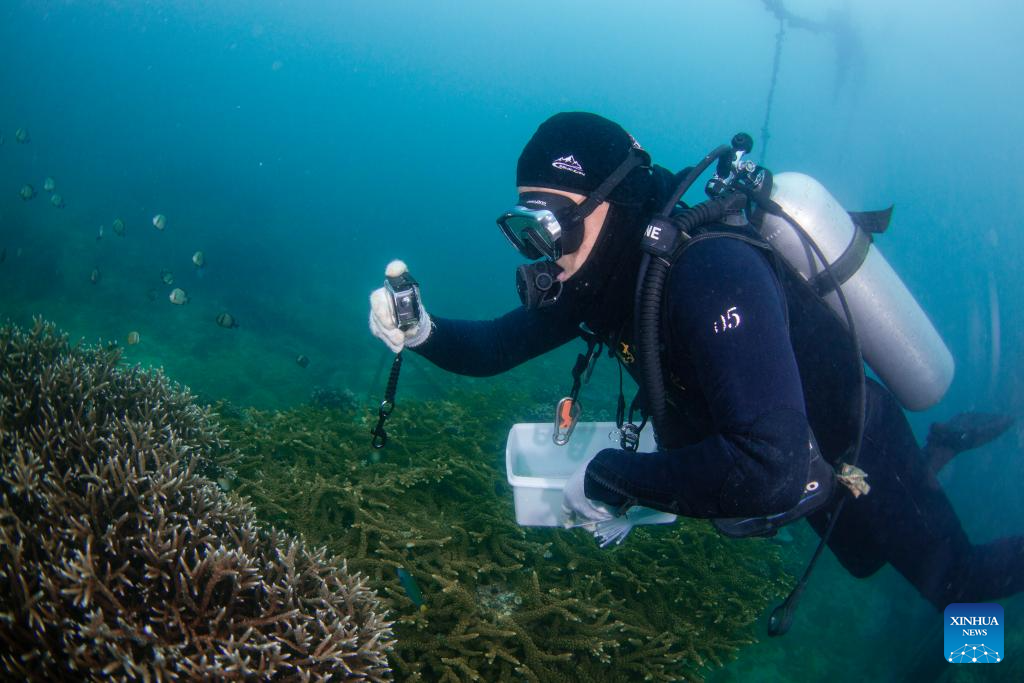
A staff member takes photos of planted corals at the marine ranch of Wuzhizhou Island in Sanya, south China's Hainan Province, May 27, 2025. Around 2010, the Wuzhizhou Island in Sanya, a city renowned for its tropical climate and one of the most popular tourist destinations in China, began building China's first tropical marine ranch to restore the underwater ecology damaged by typhoons and fishing activities. The waters surrounding the island contain numerous species such as sea cucumbers, sea urchins, and tropical fish.
Marine ranching involves placing artificial reefs, including cement frames and old iron boats, at fixed sites under seawater, which can attract fish, shrimps, crabs, shellfish and other marine life to forage, rest and reproduce.
A coral restoration program was launched here in 2016. Since its launch, the marine ranch has transplanted more than 40,000 corals. The coral restoration program has transformed Wuzhizhou, a popular diving destination, into a model of sustainable marine tourism where ecological improvement and tourism coexist harmoniously. (Xinhua/Zhang Liyun)
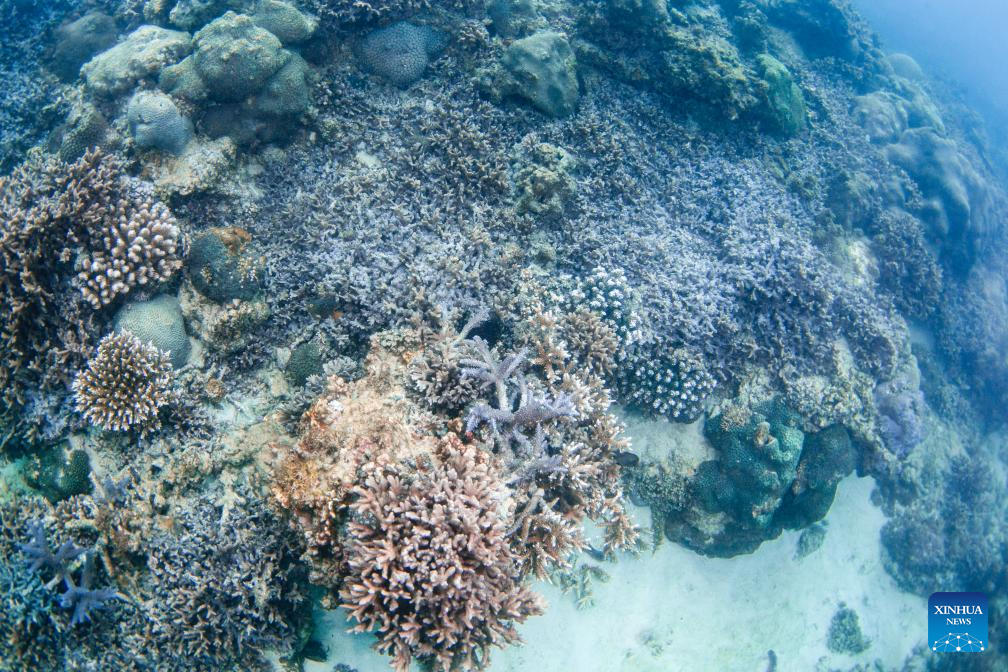
This photo taken on May 27, 2025 shows a scene of the marine ranch in the waters off Wuzhizhou Island in Sanya, south China's Hainan Province. Around 2010, the Wuzhizhou Island in Sanya, a city renowned for its tropical climate and one of the most popular tourist destinations in China, began building China's first tropical marine ranch to restore the underwater ecology damaged by typhoons and fishing activities. The waters surrounding the island contain numerous species such as sea cucumbers, sea urchins, and tropical fish.
Marine ranching involves placing artificial reefs, including cement frames and old iron boats, at fixed sites under seawater, which can attract fish, shrimps, crabs, shellfish and other marine life to forage, rest and reproduce.
A coral restoration program was launched here in 2016. Since its launch, the marine ranch has transplanted more than 40,000 corals. The coral restoration program has transformed Wuzhizhou, a popular diving destination, into a model of sustainable marine tourism where ecological improvement and tourism coexist harmoniously. (Xinhua/Zhang Liyun)

This photo taken on May 27, 2025 shows a scene of the marine ranch in the waters off Wuzhizhou Island in Sanya, south China's Hainan Province. Around 2010, the Wuzhizhou Island in Sanya, a city renowned for its tropical climate and one of the most popular tourist destinations in China, began building China's first tropical marine ranch to restore the underwater ecology damaged by typhoons and fishing activities. The waters surrounding the island contain numerous species such as sea cucumbers, sea urchins, and tropical fish.
Marine ranching involves placing artificial reefs, including cement frames and old iron boats, at fixed sites under seawater, which can attract fish, shrimps, crabs, shellfish and other marine life to forage, rest and reproduce.
A coral restoration program was launched here in 2016. Since its launch, the marine ranch has transplanted more than 40,000 corals. The coral restoration program has transformed Wuzhizhou, a popular diving destination, into a model of sustainable marine tourism where ecological improvement and tourism coexist harmoniously. (Xinhua/Zhang Liyun)
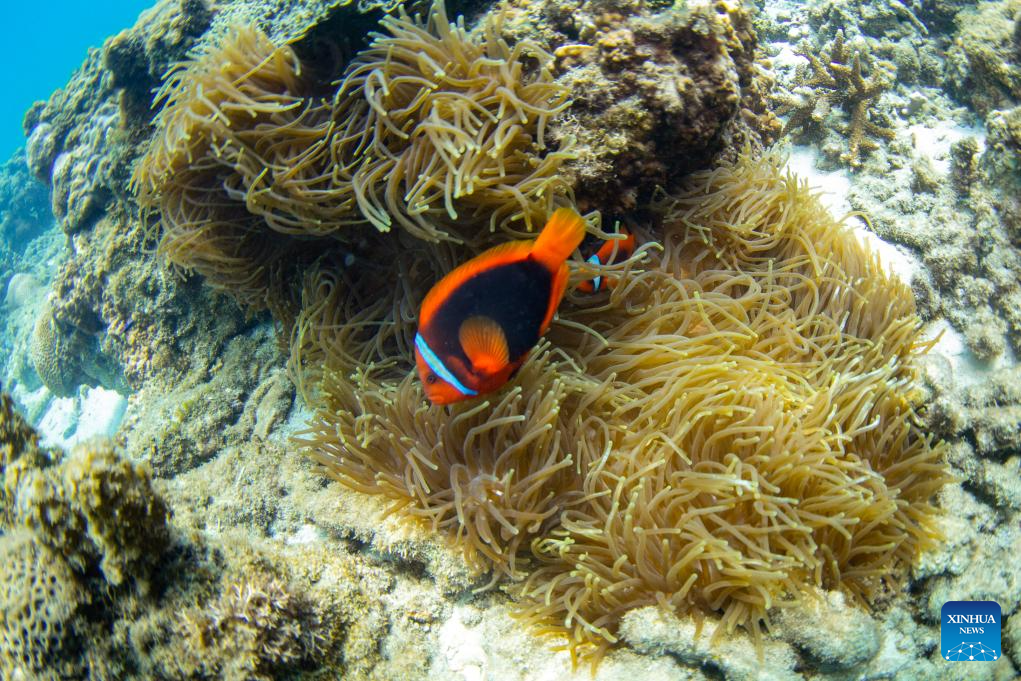
This photo taken on May 26, 2025 shows a scene of the marine ranch in the waters off Wuzhizhou Island in Sanya, south China's Hainan Province. Around 2010, the Wuzhizhou Island in Sanya, a city renowned for its tropical climate and one of the most popular tourist destinations in China, began building China's first tropical marine ranch to restore the underwater ecology damaged by typhoons and fishing activities. The waters surrounding the island contain numerous species such as sea cucumbers, sea urchins, and tropical fish.
Marine ranching involves placing artificial reefs, including cement frames and old iron boats, at fixed sites under seawater, which can attract fish, shrimps, crabs, shellfish and other marine life to forage, rest and reproduce.
A coral restoration program was launched here in 2016. Since its launch, the marine ranch has transplanted more than 40,000 corals. The coral restoration program has transformed Wuzhizhou, a popular diving destination, into a model of sustainable marine tourism where ecological improvement and tourism coexist harmoniously. (Xinhua/Zhang Liyun)
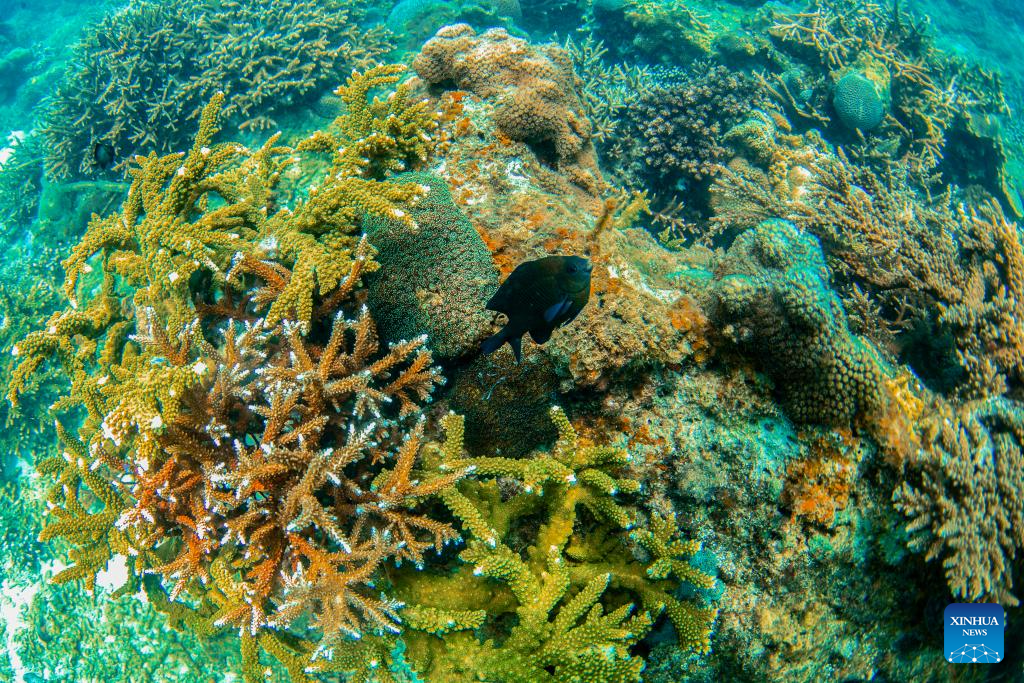
This photo taken on May 26, 2025 shows a scene of the marine ranch in the waters off Wuzhizhou Island in Sanya, south China's Hainan Province. Around 2010, the Wuzhizhou Island in Sanya, a city renowned for its tropical climate and one of the most popular tourist destinations in China, began building China's first tropical marine ranch to restore the underwater ecology damaged by typhoons and fishing activities. The waters surrounding the island contain numerous species such as sea cucumbers, sea urchins, and tropical fish.
Marine ranching involves placing artificial reefs, including cement frames and old iron boats, at fixed sites under seawater, which can attract fish, shrimps, crabs, shellfish and other marine life to forage, rest and reproduce.
A coral restoration program was launched here in 2016. Since its launch, the marine ranch has transplanted more than 40,000 corals. The coral restoration program has transformed Wuzhizhou, a popular diving destination, into a model of sustainable marine tourism where ecological improvement and tourism coexist harmoniously. (Xinhua/Zhang Liyun)
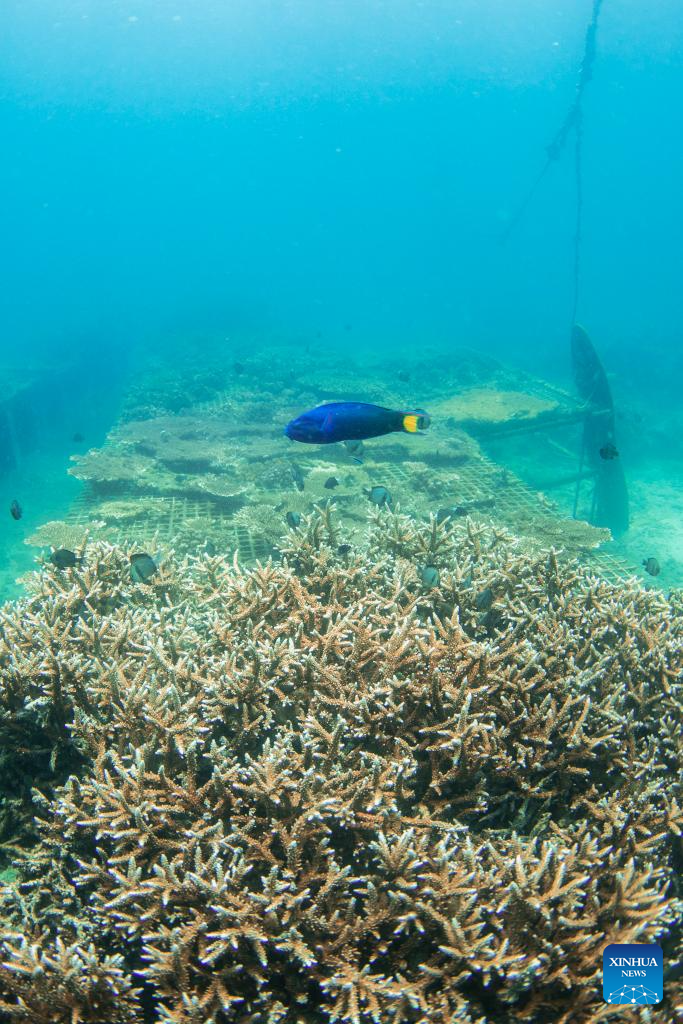
This photo taken on May 26, 2025 shows a scene of the marine ranch in the waters off Wuzhizhou Island in Sanya, south China's Hainan Province. Around 2010, the Wuzhizhou Island in Sanya, a city renowned for its tropical climate and one of the most popular tourist destinations in China, began building China's first tropical marine ranch to restore the underwater ecology damaged by typhoons and fishing activities. The waters surrounding the island contain numerous species such as sea cucumbers, sea urchins, and tropical fish.
Marine ranching involves placing artificial reefs, including cement frames and old iron boats, at fixed sites under seawater, which can attract fish, shrimps, crabs, shellfish and other marine life to forage, rest and reproduce.
A coral restoration program was launched here in 2016. Since its launch, the marine ranch has transplanted more than 40,000 corals. The coral restoration program has transformed Wuzhizhou, a popular diving destination, into a model of sustainable marine tourism where ecological improvement and tourism coexist harmoniously. (Xinhua/Zhang Liyun)
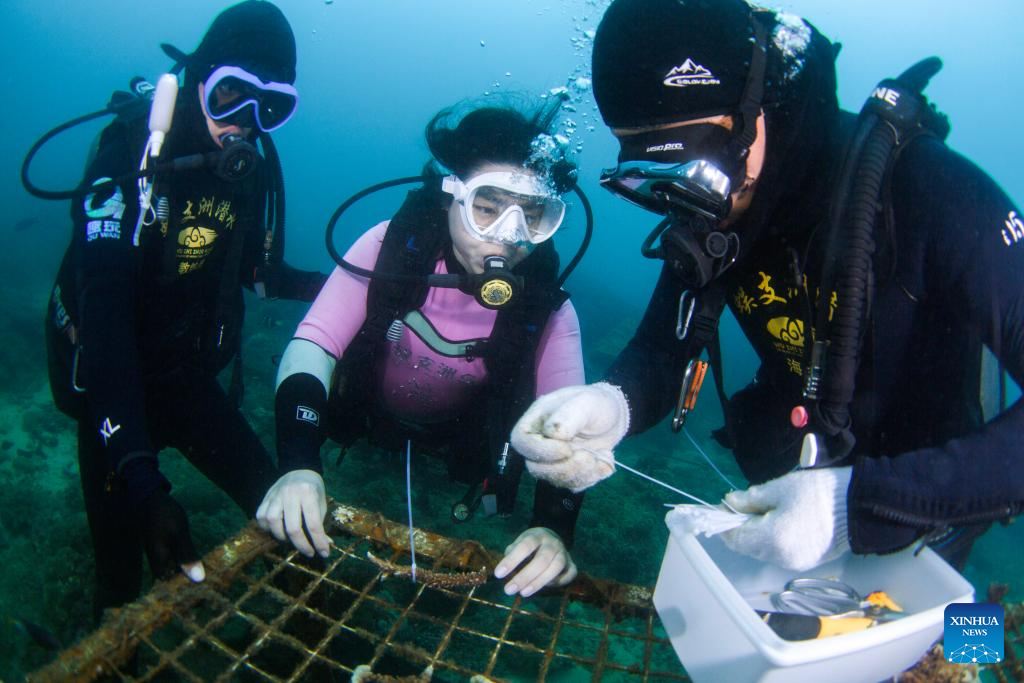
A journalist (C) tries to plant corals at the marine ranch of Wuzhizhou Island in Sanya, south China's Hainan Province, May 27, 2025. Around 2010, the Wuzhizhou Island in Sanya, a city renowned for its tropical climate and one of the most popular tourist destinations in China, began building China's first tropical marine ranch to restore the underwater ecology damaged by typhoons and fishing activities. The waters surrounding the island contain numerous species such as sea cucumbers, sea urchins, and tropical fish.
Marine ranching involves placing artificial reefs, including cement frames and old iron boats, at fixed sites under seawater, which can attract fish, shrimps, crabs, shellfish and other marine life to forage, rest and reproduce.
A coral restoration program was launched here in 2016. Since its launch, the marine ranch has transplanted more than 40,000 corals. The coral restoration program has transformed Wuzhizhou, a popular diving destination, into a model of sustainable marine tourism where ecological improvement and tourism coexist harmoniously. (Xinhua/Zhang Liyun)
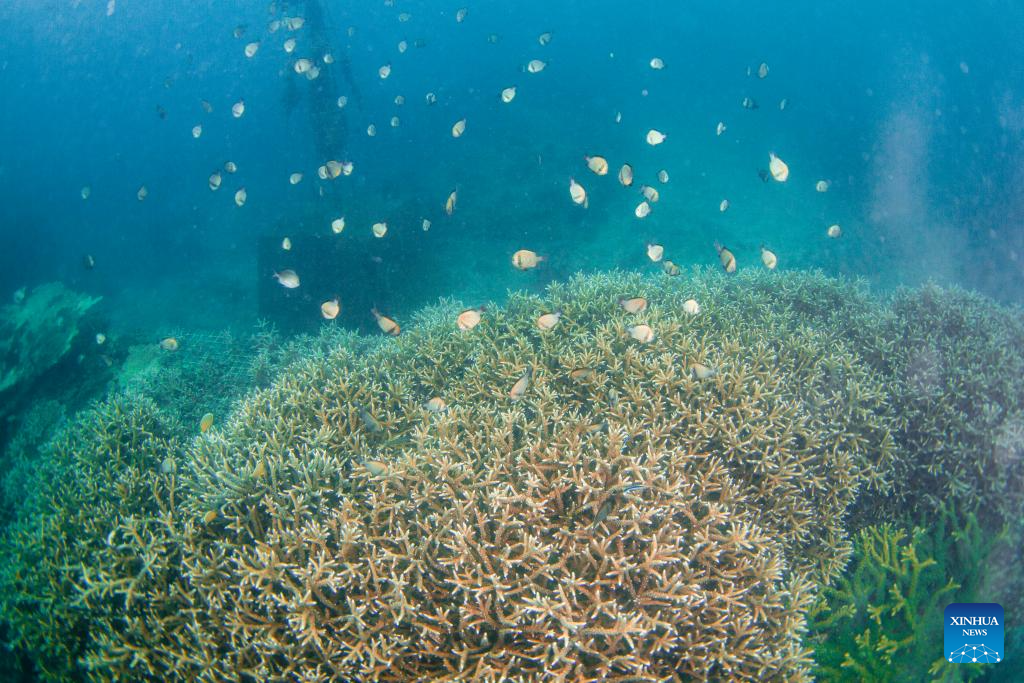
This photo taken on May 27, 2025 shows a scene of the marine ranch in the waters off Wuzhizhou Island in Sanya, south China's Hainan Province. Around 2010, the Wuzhizhou Island in Sanya, a city renowned for its tropical climate and one of the most popular tourist destinations in China, began building China's first tropical marine ranch to restore the underwater ecology damaged by typhoons and fishing activities. The waters surrounding the island contain numerous species such as sea cucumbers, sea urchins, and tropical fish.
Marine ranching involves placing artificial reefs, including cement frames and old iron boats, at fixed sites under seawater, which can attract fish, shrimps, crabs, shellfish and other marine life to forage, rest and reproduce.
A coral restoration program was launched here in 2016. Since its launch, the marine ranch has transplanted more than 40,000 corals. The coral restoration program has transformed Wuzhizhou, a popular diving destination, into a model of sustainable marine tourism where ecological improvement and tourism coexist harmoniously. (Xinhua/Zhang Liyun)
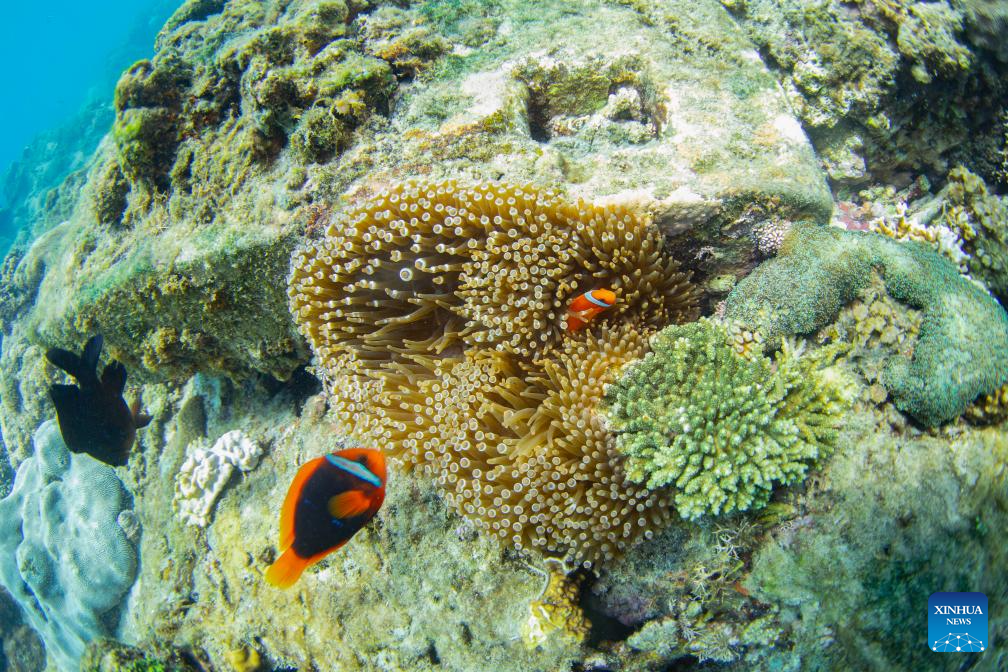
This photo taken on May 26, 2025 shows a scene of the marine ranch in the waters off Wuzhizhou Island in Sanya, south China's Hainan Province. Around 2010, the Wuzhizhou Island in Sanya, a city renowned for its tropical climate and one of the most popular tourist destinations in China, began building China's first tropical marine ranch to restore the underwater ecology damaged by typhoons and fishing activities. The waters surrounding the island contain numerous species such as sea cucumbers, sea urchins, and tropical fish.
Marine ranching involves placing artificial reefs, including cement frames and old iron boats, at fixed sites under seawater, which can attract fish, shrimps, crabs, shellfish and other marine life to forage, rest and reproduce.
A coral restoration program was launched here in 2016. Since its launch, the marine ranch has transplanted more than 40,000 corals. The coral restoration program has transformed Wuzhizhou, a popular diving destination, into a model of sustainable marine tourism where ecological improvement and tourism coexist harmoniously. (Xinhua/Zhang Liyun)
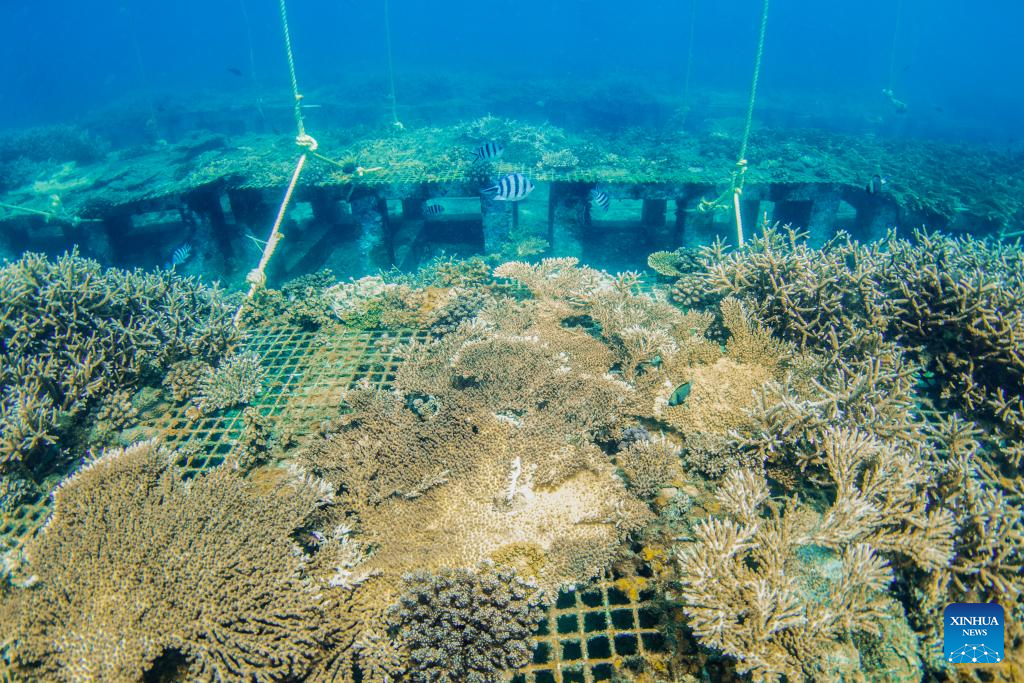
This photo taken on May 26, 2025 shows a scene of the marine ranch in the waters off Wuzhizhou Island in Sanya, south China's Hainan Province. Around 2010, the Wuzhizhou Island in Sanya, a city renowned for its tropical climate and one of the most popular tourist destinations in China, began building China's first tropical marine ranch to restore the underwater ecology damaged by typhoons and fishing activities. The waters surrounding the island contain numerous species such as sea cucumbers, sea urchins, and tropical fish.
Marine ranching involves placing artificial reefs, including cement frames and old iron boats, at fixed sites under seawater, which can attract fish, shrimps, crabs, shellfish and other marine life to forage, rest and reproduce.
A coral restoration program was launched here in 2016. Since its launch, the marine ranch has transplanted more than 40,000 corals. The coral restoration program has transformed Wuzhizhou, a popular diving destination, into a model of sustainable marine tourism where ecological improvement and tourism coexist harmoniously. (Xinhua/Zhang Liyun)
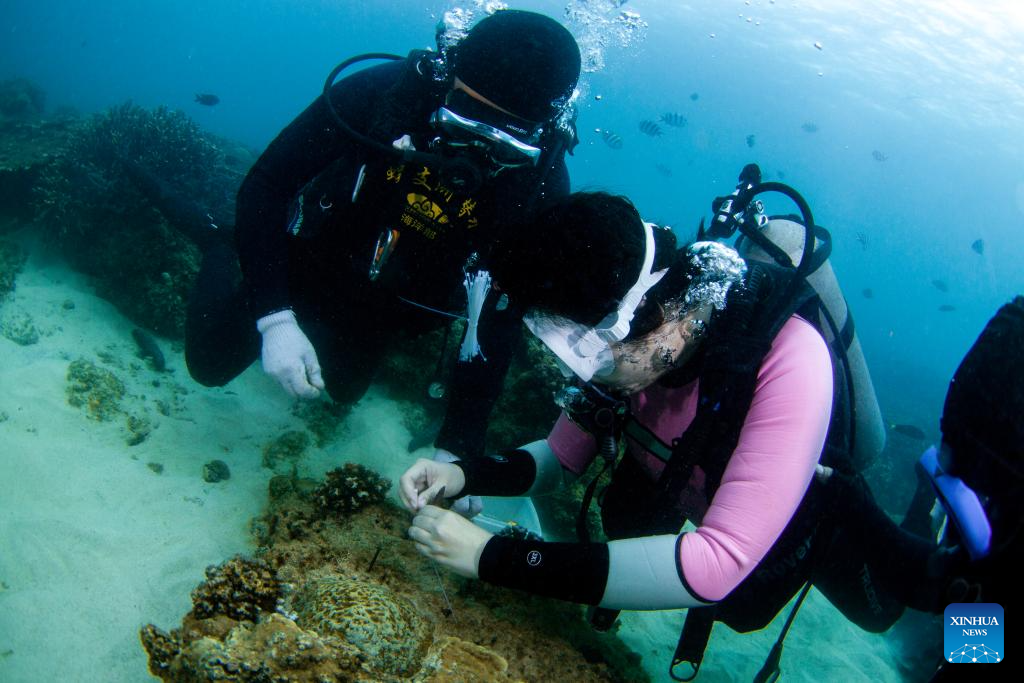
A journalist (R) tries to plant corals at the marine ranch of Wuzhizhou Island in Sanya, south China's Hainan Province, May 27, 2025. Around 2010, the Wuzhizhou Island in Sanya, a city renowned for its tropical climate and one of the most popular tourist destinations in China, began building China's first tropical marine ranch to restore the underwater ecology damaged by typhoons and fishing activities. The waters surrounding the island contain numerous species such as sea cucumbers, sea urchins, and tropical fish.
Marine ranching involves placing artificial reefs, including cement frames and old iron boats, at fixed sites under seawater, which can attract fish, shrimps, crabs, shellfish and other marine life to forage, rest and reproduce.
A coral restoration program was launched here in 2016. Since its launch, the marine ranch has transplanted more than 40,000 corals. The coral restoration program has transformed Wuzhizhou, a popular diving destination, into a model of sustainable marine tourism where ecological improvement and tourism coexist harmoniously. (Xinhua/Zhang Liyun)
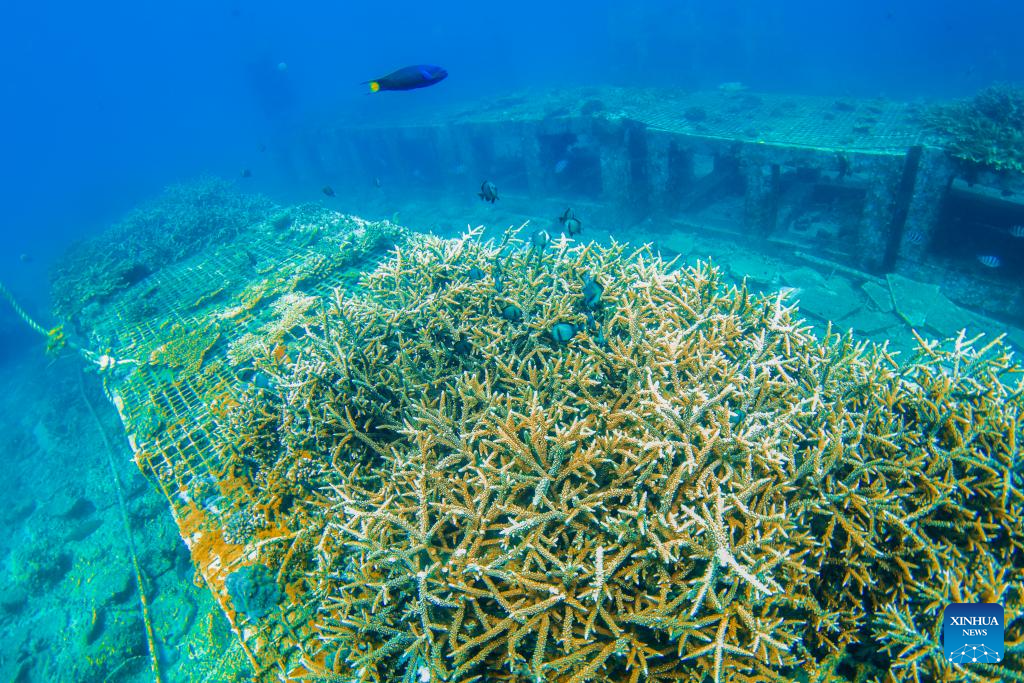
This photo taken on May 26, 2025 shows a scene of the marine ranch in the waters off Wuzhizhou Island in Sanya, south China's Hainan Province. Around 2010, the Wuzhizhou Island in Sanya, a city renowned for its tropical climate and one of the most popular tourist destinations in China, began building China's first tropical marine ranch to restore the underwater ecology damaged by typhoons and fishing activities. The waters surrounding the island contain numerous species such as sea cucumbers, sea urchins, and tropical fish.
Marine ranching involves placing artificial reefs, including cement frames and old iron boats, at fixed sites under seawater, which can attract fish, shrimps, crabs, shellfish and other marine life to forage, rest and reproduce.
A coral restoration program was launched here in 2016. Since its launch, the marine ranch has transplanted more than 40,000 corals. The coral restoration program has transformed Wuzhizhou, a popular diving destination, into a model of sustainable marine tourism where ecological improvement and tourism coexist harmoniously. (Xinhua/Zhang Liyun)
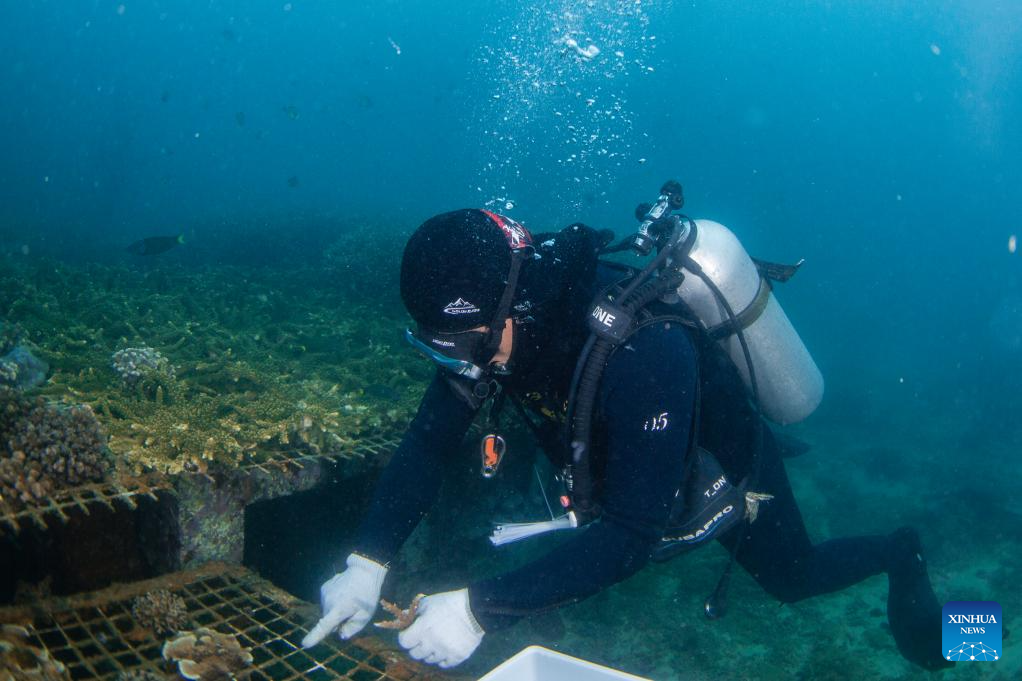
A staff member plants corals at the marine ranch of Wuzhizhou Island in Sanya, south China's Hainan Province, May 27, 2025. Around 2010, the Wuzhizhou Island in Sanya, a city renowned for its tropical climate and one of the most popular tourist destinations in China, began building China's first tropical marine ranch to restore the underwater ecology damaged by typhoons and fishing activities. The waters surrounding the island contain numerous species such as sea cucumbers, sea urchins, and tropical fish.
Marine ranching involves placing artificial reefs, including cement frames and old iron boats, at fixed sites under seawater, which can attract fish, shrimps, crabs, shellfish and other marine life to forage, rest and reproduce.
A coral restoration program was launched here in 2016. Since its launch, the marine ranch has transplanted more than 40,000 corals. The coral restoration program has transformed Wuzhizhou, a popular diving destination, into a model of sustainable marine tourism where ecological improvement and tourism coexist harmoniously. (Xinhua/Zhang Liyun)
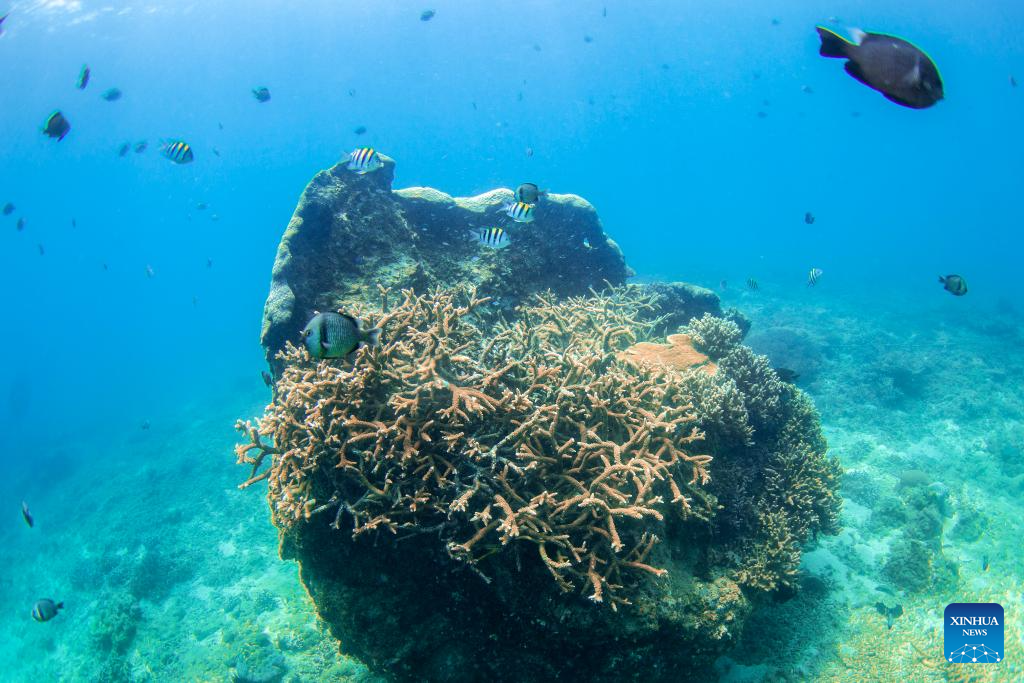
This photo taken on May 26, 2025 shows a scene of the marine ranch in the waters off Wuzhizhou Island in Sanya, south China's Hainan Province. Around 2010, the Wuzhizhou Island in Sanya, a city renowned for its tropical climate and one of the most popular tourist destinations in China, began building China's first tropical marine ranch to restore the underwater ecology damaged by typhoons and fishing activities. The waters surrounding the island contain numerous species such as sea cucumbers, sea urchins, and tropical fish.
Marine ranching involves placing artificial reefs, including cement frames and old iron boats, at fixed sites under seawater, which can attract fish, shrimps, crabs, shellfish and other marine life to forage, rest and reproduce.
A coral restoration program was launched here in 2016. Since its launch, the marine ranch has transplanted more than 40,000 corals. The coral restoration program has transformed Wuzhizhou, a popular diving destination, into a model of sustainable marine tourism where ecological improvement and tourism coexist harmoniously. (Xinhua/Zhang Liyun)



